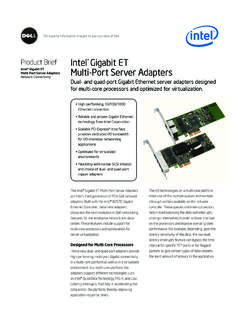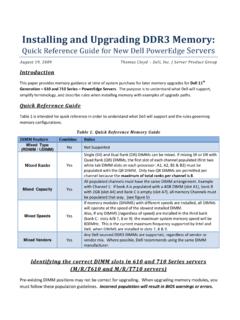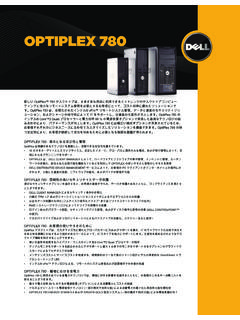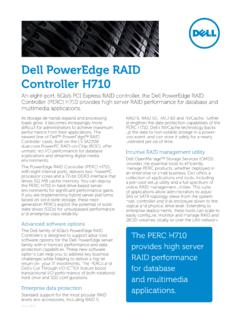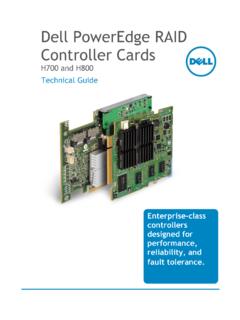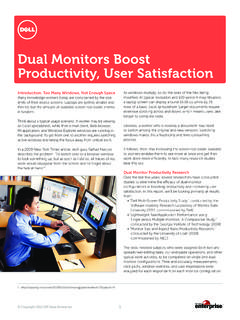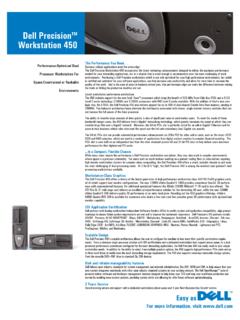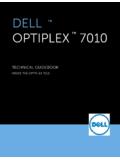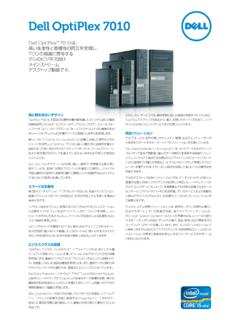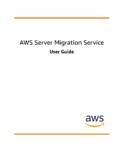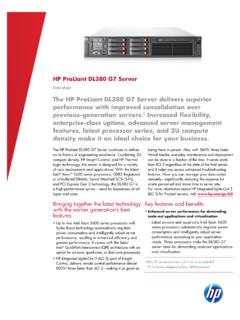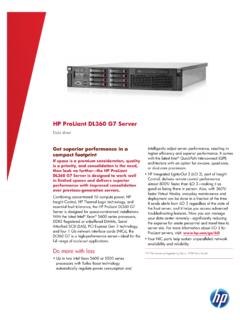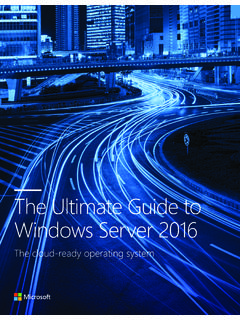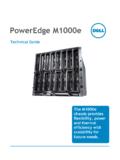Transcription of What Is a Server? - Dell United States
1 What Is a server ? For the small business owner, adding a server to your network doesn t need to be a daunting task If you don't already have a server in your business, you're probably already using a desktop system as a server of sorts. Maybe it controls some files or printers that you can share with other PCs, but there are key differences between servers and desktops, and many good reasons to invest in a server for your small business. First and foremost, you need to understand these key differences between servers and desktop computers. So let's look at some of those differences. On the surface, they seem very similar. Both have a CPU, RAM, and hard drives for storage. Servers, however, are designed with heavy duty back end tasks in mind, and aren't well equipped to run normal desktop workloads, such as graphics intensive applications. Servers excel at running services supporting those desktop applications, such as databases. The CPU in an entry level server isn't all that different from a midlevel desktop, but does differ in some ways, such as cache sizes.
2 To put it simply, CPU cache is a small, dedicated pool of RAM that the CPU can use to store frequently requested data. If the cache is larger, the CPU appears faster because it can store more data in the cache for faster recall. server CPUs generally have larger and more varied caches than desktop systems for just this reason. Like modern desktop systems, server CPUs can have multiple cores, although they generally make better use of multiple cores than desktop systems will. Multiple core CPUs are basically a single CPU that contains two or more processing cores. In essence, it s like having several CPUs on a single chip. Using multicore CPUs can greatly increase the processing power of the system and lengthen the usable life of your server . Some entry level servers, such as an Intel Celeron 445, may have a single core CPUs. For an office of fewer than 10 users, this is generally sufficient. Be aware, though, that a few extra dollars invested now in on a higher powered server say a dual or even a quad core CPU can be greatly beneficial as your business grows.
3 Overestimating your needs now might be your best bet. UNDERSTANDING RAID One of the major hardware differences between servers and workstations is the disk subsystem. While desktops have a single hard drive, servers generally have several hard drives configured to appear as a single disk. This is called RAID, or Redundant Array of Inexpensive Disks. RAID is widely used to protect servers from individual disk failures, critical when your business is at stake. If a drive in a RAID array fails, it does not mean that the data contained on that drive is lost, since other drives in the array still contain the data. There are multiple levels of RAID, but for entry level servers, RAID levels 1 and 5 are the most common. RAID level 1 is a simple mirror of two hard drives. The data stored on a RAID 1 array exists on both drives at all times. If one drive fails, the other drive still has a complete copy of the data, and the server can continue to function. RAID 5 is more complex, involving at least three drives, and the setup can survive the failure of any one drive.
4 Either option will protect against failures, but RAID 5 delivers more available disk space than RAID 1 and is faster as well. This data protection is crucial to a server , and any server you add should be equipped with a RAID controller and a RAID array. Make sure a hardware based RAID controller is in the server as well, not just a software based one software based RAID works, but can be more problematic for the uninitiated, since there isn t a dedicated controller managing the hard drives. If you re using software RAID only, you may run into difficulty in the event of a disk failure, especially if you re not an expert at software RAID recovery procedures. The disks in servers are also generally different than those in desktops. There's more to hard drives than just size the speed at which the platters within the drive spin can greatly affect performance of the entire server . Hard drives running at 10,000 RPM can deliver data faster than slower drives running at 5,400 RPM, especially under load.
5 There are several different types of hard drives as well, such as SATA and SAS drives. For most entry level servers, 7,200 RPM SATA drives configured in a RAID1 or RAID 5 array will be sufficient. For higher performance, you may want to consider SAS drives. Generally, higher performance disks are necessary only if the server will be running heavier applications, such as a large database. Some entry level servers offer hot swappable hard drives, while others do not. Hot swappable drives enable a hard drive to be replaced without shutting the server down or even opening the case. If a disk fails, it can be pulled out of the running server and replaced. When the disk is replaced, the RAID controller will then rebuild the RAID array to ensure that the data is protected. If the server does not have hot swappable hard drives, then the server must be shut down, opened, and the failed hard drive replaced inside the system. RACK VS. TOWER Entry level servers are generally available in either a rack mount or tower form.
6 If this is the first server for the company, you probably won t have a suitable server rack already in place, and for a single server , adding that rack may not be cost effective. Thus, a tower server is likely to be the best option. Many tower servers can later be converted to rack mount servers with the appropriate conversion kit, so if your infrastructure grows to the point where a rack is required, your existing investment can be modified to fit your needs. A tower server is generally only slightly larger than a regular desktop system, and can be placed under a desk or in an area that has little traffic. Though it s a good idea to also have a monitor, keyboard, and mouse hooked up to the server , don t be tempted to use the server as a desktop system. A WORD ABOUT RAM Servers also generally have very fast RAM, which is quite important for performance. Since servers are running many different tasks simultaneously, fast RAM and a fast system bus are crucial to maintain smooth operation.
7 ECC, or error correcting, RAM is also a feature of most server class systems. ECC helps protect the integrity of the data stored in RAM during normal processing. It costs a bit more than non ECC RAM, but in a server system, it s generally a requirement. Another feature of most servers is redundant power supplies. This means that the server has at least two power supplies that both draw power during normal operation. If one power supply fails, or power is cut to that supply, the server continues to function. Not all servers have this feature, but some offer the option of adding another power supply later on. As with any computer, you should add a UPS (Uninterruptible Power Supply) to protect your server from power surges and outages. THE STRIPPED DOWN server Since servers aren't really meant to run desktop applications, their graphics subsystems are generally very basic. Many servers don't even have a keyboard, monitor, or mouse plugged into them, since they can be managed through the network.
8 In a small business environment, however, you may usefully have a monitor, keyboard, and mouse on your server , especially if it's the only one. Most entry level servers are only slightly larger than desktop systems and can fit under a desk or in a corner. Make sure that there s adequate ventilation and climate control wherever you place the server . For connecting to the network, most servers have at least one gigabit network interface (the piece of hardware that talks to the network). These interfaces are different than the network cards in desktops since they perform certain network functions by themselves, relieving the server 's CPU to handle more complex tasks. The end result is that they can push more data under load than normal network interfaces. If multiple interfaces are in the server , they can even be bonded together to provide greater bandwidth. By adding a server even an entry level server to your network, you can benefit greatly from these features, especially considering the data protection available in a RAID array.
9 Also, by adding a server , you reduce the likelihood of spyware and viruses impacting your business data, as long as you run strong antivirus software on the server . For the most part, servers in small business settings are designed to run a large number of different services and applications to support a small number of users. Products like Microsoft's Small Business server are designed to do just that. They offer many different functions that can run on a single dedicated server , but they can support only a relatively small number of users. In many small business environments, this is all that's necessary. And there's one more bit of good news: These days, entry level servers are available for nearly the same cost as midlevel desktops, making them a natural for small businesses.
